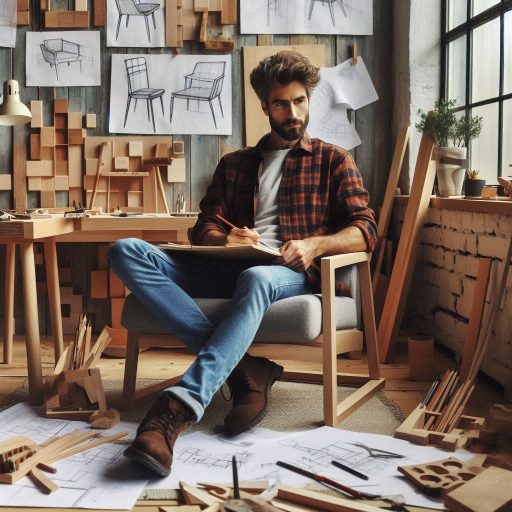Introduction
The 21st century has witnessed a remarkable evolution in furniture design.
As lifestyles change, so do our needs and preferences for furniture.
Today, furniture serves not just functional purposes but also reflects personal style and values.
Designers now prioritize sustainability, functionality, and aesthetics.
They incorporate eco-friendly materials and innovative technologies in their creations.
Smart furniture, equipped with technology, is increasingly popular in homes and offices.
This trend reflects our growing reliance on technology in daily life.
Furthermore, the rise of minimalism influences furniture design, emphasizing simplicity and efficiency.
Designers focus on creating versatile pieces that maximize space in smaller living areas.
This shift responds to urbanization and changing family dynamics.
Cultural influences also play a vital role in contemporary furniture design.
Globalization has exposed designers to diverse styles, fostering creativity and innovation.
As we progress through the 21st century, furniture design continues to evolve.
It adapts to our changing lifestyles while enhancing our daily lives.
Understanding this evolution allows us to appreciate the artistry behind modern furniture.
Historical Background
History of furniture design from the 20th century to the present
The 20th century marked a significant shift in furniture design, driven by changes in society, technology, and culture.
The era embraced modernism, rejecting ornate styles that characterized the previous centuries.
Designers sought functionality and simplicity in their creations.
Movements like Bauhaus, which emerged in the 1920s, emphasized minimalism and mass production.
This approach transformed furniture into accessible, practical pieces for the masses, reflecting the ideals of the time.
The mid-century modern movement further reshaped design principles.
Influential designers like Charles and Ray Eames popularized organic forms and innovative materials such as molded plywood and fiberglass.
Their chairs became iconic, showcasing the balance of aesthetics and comfort.
The sleek lines and functional designs of this period appealed to a wide audience, making mid-century modern furniture timeless and sought after.
Key movements and styles that have influenced 21st-century design
Post-World War II, designers explored new materials that expanded creative possibilities.
Plastics, plywood, and metal became popular choices among furniture makers.
Designs reflected the changing lifestyles of consumers, as people sought versatility and adaptability in their furnishings.
This era encouraged experimentation and creativity, leading to distinctive styles that showcased artistic expression.
The Scandinavian design movement also gained prominence during this time.
Designers like Arne Jacobsen and Hans Wegner championed simplicity, craftsmanship, and natural materials.
Their work emphasized a connection to nature and human scale, further influencing the design landscape.
By the late 20th century, global influences began to emerge more prominently in furniture design.
Designers drew inspiration from various cultures and traditions, leading to an eclectic mix of styles.
This melding of influences contributed to a rich tapestry of design, setting the stage for the diverse landscape of 21st-century furniture design.
In the 21st century, sustainability became a crucial consideration for designers.
A growing awareness of environmental impact led to a shift in priorities.
Designers began to incorporate eco-friendly materials and sustainable production methods into their work.
Furniture design now often includes renewable resources and recycled materials, catering to a consumer demand for responsible design.
Iconic designers and their contributions to the field
Technological advancements have also transformed the furniture design landscape.
The rise of digital fabrication tools, such as CNC machines and 3D printers, has enabled designers to create complex shapes and structures with ease.
This technology allows for personalized, unique pieces tailored to individual needs, broadening the scope of what is possible in furniture design.
Iconic designers continue to shape the field today.
Patricia Urquiola’s work blends traditional craftsmanship with modern aesthetics.
Her designs reflect a playful yet functional approach to furniture, appealing to a broad audience.
Similarly, Philippe Starck’s creations challenge conventions and push boundaries.
His iconic pieces often serve as statement art while maintaining practicality.
The evolution of furniture design in the 21st century reflects a rich history.
It blends past influences with contemporary ideals.
Key movements and innovative designers shape today’s designs, ensuring that furniture remains functional, beautiful, and reflective of current values.
As we move forward, furniture design will continue to adapt and evolve, responding to the needs of future generations.
Read: Top Skills Needed for Art Educators and Instructors
Technology and Innovation
How advancements in technology have impacted furniture design
Advancements in technology have dramatically transformed furniture design in the 21st century.
Designers now have access to innovative tools and resources that allow for greater creativity and efficiency.
Digital design software enables them to visualize concepts in three dimensions before production.
This technology streamlines the design process and facilitates collaboration among designers, manufacturers, and clients.
Additionally, computer-aided design (CAD) programs allow for precise measurements and adjustments, ensuring that each piece fits seamlessly into a given space.
The rise of digital fabrication methods has also revolutionized the industry.
Technologies such as laser cutting and CNC machining enable the creation of complex shapes and intricate details with unparalleled precision.
These methods reduce material waste and allow for customization, making it easier to produce unique, one-of-a-kind pieces.
As a result, designers can experiment with forms and aesthetics, pushing the boundaries of traditional furniture design.
The use of new materials, manufacturing processes, and sustainability in design
The introduction of new materials has further influenced furniture design.
Innovative substances like molded plywood, fiberglass, and bioplastics provide designers with versatile options.
These materials not only enhance aesthetic appeal but also improve functionality and durability.
For example, composite materials can be lightweight yet strong, allowing for innovative designs that maintain structural integrity.
Sustainability has become a crucial focus in furniture design due to increased awareness of environmental issues.
Designers now prioritize eco-friendly materials and processes in their creations.
Many furniture makers are incorporating reclaimed wood, recycled metals, and low-impact fabrics into their products.
This shift reflects a commitment to reducing waste and promoting responsible sourcing.
As consumers demand more sustainable options, designers are responding by creating pieces that align with eco-conscious values.
Examples of innovative furniture designs that have emerged in the 21st century
Several innovative furniture designs have emerged in the 21st century, showcasing the intersection of technology, materials, and sustainability.
The “Smart Furniture” trend incorporates technology directly into designs, enabling features like adjustable height desks and charging stations integrated into tables.
These multifunctional pieces cater to the modern lifestyle, enhancing convenience and usability.
Another notable example is the “Bend” chair by designer Alvaro Uribe.
This chair utilizes a single sheet of bent plywood to create a lightweight, elegant form.
It exemplifies the effective use of materials and technology to produce a stylish yet functional piece.
The “Eco-Friendly” movement has also inspired designers like Patricia Urquiola, who creates pieces that emphasize sustainability without sacrificing aesthetics.
Her “Lilo” chair uses recycled materials and has a playful, inviting design that appeals to a broad audience.
The impact of technology and innovation on furniture design is profound.
These advancements not only shape the aesthetics and functionality of pieces but also reflect changing consumer values.
As the industry continues to evolve, the integration of technology, new materials, and sustainability will remain key drivers of creativity and progress.
Designers will continue to explore these avenues, creating furniture that meets the needs of contemporary society while promoting a sustainable future.
Read: Collaborating with Other Creative Roles
Minimalism and Functionality
The trend towards minimalism and simplicity in furniture design
The trend towards minimalism in furniture design has gained momentum in recent years.
This shift emphasizes simplicity and clarity over excess.
Minimalism reflects a desire for calm and order in increasingly chaotic lives.
Designers focus on clean lines, neutral colors, and unobtrusive shapes.
This approach allows spaces to feel more open and inviting.
The minimalist aesthetic aligns with modern lifestyles, where functionality often takes precedence over decorative elements.
As a result, furniture becomes an integral part of the space rather than an overwhelming presence.
How functionality and practicality have become essential elements in modern furniture
Functionality and practicality have emerged as essential elements in modern furniture design.
Consumers prioritize pieces that serve multiple purposes.
This need stems from smaller living spaces and the desire for efficient use of available space.
Designers respond by creating adaptable and versatile furniture solutions.
For example, sofas that convert into beds or coffee tables with hidden storage appeal to those seeking practicality.
This trend is not just about saving space; it also enhances the overall user experience.
Furniture that is easy to use and meets everyday needs resonates with consumers.
Moreover, functionality often dictates the choice of materials and construction methods.
Designers incorporate durable and sustainable materials, ensuring longevity and ease of maintenance.
Pieces that withstand the test of time are highly valued.
As a result, consumers feel more confident in their purchases, knowing they invest in quality products.
Popular minimalist furniture pieces and their designs
Several iconic minimalist furniture pieces exemplify this trend.
The Eames Lounge Chair, designed by Charles and Ray Eames, blends comfort with clean lines.
Its combination of molded plywood and leather creates an inviting yet sophisticated look.
Another notable piece is the Muji’s minimalist shelving units, which emphasize practicality while maintaining an uncluttered aesthetic.
Their simple design complements various interior styles.
The Nesting Tables by Hans Wegner also highlight minimalist principles.
These tables offer flexibility, as they can be used individually or stacked together, conserving space when not in use.
The design’s simplicity allows them to blend seamlessly into any room while remaining functional.
Additionally, the Tansu Bed by the Japanese company Nitori showcases minimalism in its design.
With its low profile and natural wood finish, it embodies simplicity while offering a serene sleeping environment.
This piece reflects the essence of Japanese minimalism, where less truly is more.
The trend towards minimalism and functionality in furniture design resonates deeply with modern consumers.
As lifestyles evolve, the demand for simplicity, practicality, and multi-functional pieces continues to grow.
Designers who embrace these principles create timeless, elegant furniture that enhances living spaces.
By prioritizing minimalism and functionality, furniture design adapts to meet the needs of contemporary life, ensuring it remains relevant for years to come.
Read: Historic Costume Design Inspirations

Eco-Friendly Design
The rise of eco-friendly and sustainable furniture design practices
In recent years, eco-friendly and sustainable furniture design practices have gained significant momentum.
As awareness of environmental issues has increased, consumers are seeking more responsible options for their homes.
Designers now recognize the importance of creating products that minimize harm to the planet.
This shift has led to innovative approaches that prioritize sustainability in every aspect of furniture design.
The rise of eco-friendly furniture reflects a growing commitment to reducing waste and promoting a greener future.
Use of recycled materials, energy-efficient production methods, and ethical sourcing in design
One major trend in sustainable furniture design is the use of recycled materials.
Designers are creatively repurposing items such as reclaimed wood, recycled metals, and even plastic waste.
This practice reduces the need for new materials while giving a second life to discarded products.
Additionally, many designers are adopting energy-efficient production methods.
These methods minimize energy consumption during manufacturing, reducing the overall carbon footprint of furniture production.
Techniques such as local sourcing and modular design further enhance sustainability by decreasing transportation emissions and waste.
Ethical sourcing has also become a crucial consideration in eco-friendly furniture design.
Designers are increasingly focused on ensuring that the materials they use are sourced responsibly.
This includes working with suppliers who follow fair labor practices and environmental regulations.
By prioritizing ethical sourcing, designers not only create beautiful pieces but also contribute to social and environmental well-being.
This holistic approach to furniture design ensures that products align with the values of environmentally conscious consumers.
Examples of eco-friendly furniture designs that are gaining popularity in the 21st century
Several eco-friendly furniture designs are gaining popularity in the 21st century.
For instance, companies like Emeco produce chairs made from recycled aluminum, showcasing both durability and sustainability.
Their iconic Navy Chair, originally designed in 1944, has been reimagined using 80% recycled materials, highlighting the potential for timeless design combined with eco-friendliness.
Another notable example is the use of bamboo in furniture design.
Bamboo is a fast-growing, renewable resource that requires minimal resources to cultivate.
Designers such as Kettal create stunning outdoor furniture collections using bamboo, which not only looks great but also demonstrates sustainable practices.
The trend of upcycled furniture is also on the rise.
Designers are transforming old furniture pieces into unique, one-of-a-kind items.
For example, a worn-out dresser can be creatively refinished and repurposed into a chic coffee table.
This practice not only reduces waste but also adds character and individuality to home decor.
Finally, companies like IKEA have committed to sustainability by integrating recycled materials into their products and focusing on renewable resources.
Their “IKEA Sustainable Life” initiative aims to create a more sustainable product range while encouraging customers to embrace eco-friendly living.
The rise of eco-friendly furniture design practices reflects a broader societal shift toward sustainability.
As consumers become more aware of their environmental impact, the demand for responsibly sourced and designed furniture will continue to grow.
This commitment to eco-friendly design ensures a healthier planet for future generations while enhancing the beauty and functionality of our living spaces.
Read: Breaking Down Iconic Movie Costumes
Customization and Personalization
The trend towards customizable and personalized furniture designs
In recent years, the trend toward customizable and personalized furniture designs has gained significant traction.
Consumers increasingly seek pieces that reflect their unique tastes and lifestyles.
This shift arises from a desire for individuality in home decor.
People no longer want generic furniture that blends into the background.
Instead, they seek items that stand out and tell a story about their personal style.
Customization allows for greater creative expression and connection to the living space.
Furniture brands and designers have embraced this trend by offering various customization options.
Many companies now provide consumers the ability to choose colors, materials, sizes, and finishes.
This flexibility ensures that each piece fits seamlessly into the buyer’s home.
Customizable furniture also caters to specific needs, such as space constraints or functional requirements.
The growing demand for personalization reflects a broader cultural shift toward valuing individuality in all aspects of life.
How consumers are seeking unique and individualized pieces for their homes
As consumers become more aware of their personal tastes, they are increasingly drawn to unique furniture pieces.
Many people prefer one-of-a-kind items over mass-produced options.
This desire for individuality is partly driven by social media, where showcasing distinctive home decor has become a trend.
Platforms like Instagram and Pinterest inspire consumers to curate unique living spaces that reflect their personalities.
Furthermore, the rise of online shopping has made it easier for consumers to access customizable options.
Many e-commerce platforms now feature tools that allow users to visualize how different choices will look in their homes.
This capability empowers consumers to make informed decisions about their furniture purchases.
The result is a more engaged consumer base that takes pride in creating personalized living environments.
Companies and designers that offer customization options for furniture
Several companies and designers have recognized this shift toward customization and personalization.
Brands like West Elm and CB2 offer extensive customization options for their furniture lines.
These companies allow customers to choose from various materials, colors, and configurations to create pieces tailored to their needs.
Another example is Made.com, a platform that specializes in designer furniture at accessible prices.
Made.com collaborates with emerging designers to produce customizable items, ensuring that customers can find pieces that resonate with their individual styles.
Additionally, designers like Patricia Urquiola and Nitori have embraced personalization in their work.
Urquiola’s designs often feature adaptable elements, while Nitori offers a range of modular furniture options that can be customized for different spaces.
The trend toward customization and personalization in furniture design reflects changing consumer preferences.
As people seek unique, individualized pieces for their homes, the industry responds by offering innovative options.
This evolution ensures that furniture design continues to align with modern lifestyles, fostering creativity and expression in every living space.
As this trend grows, it will shape the future of furniture design in exciting ways.
Transform Your Career Today
Unlock a personalized career strategy that drives real results. Get tailored advice and a roadmap designed just for you.
Start NowCultural Influence
How cultural influences have shaped furniture design in the 21st century
Cultural influences have profoundly shaped furniture design in the 21st century.
Designers increasingly draw inspiration from various cultural traditions, blending styles and elements to create unique pieces.
As the world becomes more interconnected, this cross-pollination of ideas has resulted in innovative designs that reflect a global perspective.
Different cultural backgrounds provide a wealth of inspiration, leading to furniture that resonates with diverse audiences.
Incorporating cultural elements into furniture design allows for storytelling through objects.
Designers seek to celebrate heritage while appealing to contemporary aesthetics.
This fusion creates pieces that not only serve functional purposes but also evoke emotional connections.
By embracing various cultural influences, designers have expanded the possibilities of what furniture can represent.
How global perspectives and multiculturalism have contributed to diverse design aesthetics
Global perspectives and multiculturalism play a vital role in the diversity of design aesthetics today.
Designers recognize the importance of inclusivity and representation in their work.
As a result, they create pieces that reflect various cultural narratives and experiences.
This trend has led to the emergence of styles that blend traditional craftsmanship with modern functionality.
The rise of global trade and communication has facilitated the exchange of ideas among designers from different regions.
Furniture makers now have access to a broader range of materials, techniques, and styles from around the world.
This exchange fosters innovation and creativity, resulting in furniture that challenges conventional norms.
For instance, contemporary designers often mix Eastern and Western design elements, creating unique hybrids that celebrate both traditions.
Examples of cultural elements that are being incorporated into modern furniture designs
Several cultural elements are increasingly being incorporated into modern furniture designs.
For example, Japanese design principles emphasize simplicity and natural materials, influencing contemporary pieces that prioritize minimalism and sustainability.
The use of tatami mats and shoji screens has inspired designers to create furniture that promotes harmony and tranquility in living spaces.
Additionally, African design influences have gained recognition in recent years.
Bold colors, intricate patterns, and traditional craftsmanship characterize many modern pieces inspired by African heritage.
Designers incorporate techniques like weaving and carving to pay homage to cultural practices while creating functional furniture.
This blend of heritage and innovation results in distinctive, eye-catching designs that tell a story.
Moreover, the Scandinavian design movement continues to influence global furniture aesthetics.
Its emphasis on clean lines, functionality, and natural materials resonates with a wide audience.
Designers worldwide adopt these principles while infusing their cultural perspectives, resulting in a diverse range of modern furniture.
The impact of cultural influences on 21st-century furniture design cannot be overstated.
As designers embrace global perspectives and multiculturalism, they create pieces that reflect a rich tapestry of experiences.
This dynamic landscape ensures that furniture remains not only functional but also a meaningful representation of diverse cultures.
As we continue to navigate an increasingly interconnected world, the influence of culture on design will undoubtedly evolve, inspiring future generations of designers.
Conclusion
The 21st century has transformed furniture design through innovation and technology.
Designers now prioritize sustainability, incorporating eco-friendly materials into their creations.
Advances in technology, such as 3D printing and smart furniture, revolutionize traditional design practices.
Minimalism and multifunctionality have become essential, catering to modern living spaces.
We see a rise in personalization, with consumers seeking unique pieces that reflect their style.
Furthermore, the integration of technology enhances functionality, allowing furniture to adapt to user needs.
Looking ahead, we can expect even more exciting trends, such as AI-driven designs and sustainable production methods.
These advancements will shape how we experience and interact with furniture in our daily lives.
As we appreciate the evolution of furniture design, let’s celebrate the creativity and innovation that define modern pieces.
Designers continue to challenge conventions, merging art with functionality.
This dynamic landscape promises endless possibilities for future designs.
Embrace these changes and explore the imaginative solutions that modern furniture offers.
The journey of furniture design is just beginning, and its future looks bright.
[E-Books for Sale]
The Big Book of 500 High-Paying Jobs in America: Unlock Your Earning Potential
$19.99 • 500 High-Paying Jobs • 330 pages
Explore 500 high-paying jobs in America and learn how to boost your career, earn more, and achieve success!
See All 500 High-Paying Jobs of this E-Book
1001 Professions Without a Degree: High-Paying American Jobs You Can Start Now
$19.99 • 1001 Professions Without a Degree • 174 pages
Discover 1001 high-paying jobs without a degree! Unlock career tips, skills, and success strategies for just $19.99!




